This rose kombucha recipe is a lovely second ferment, and is a wonderful way to enjoy the sweet flavor of summer. With a perfect light fizz along with rose benefits and tons of probiotics, you’ll sip this all season!
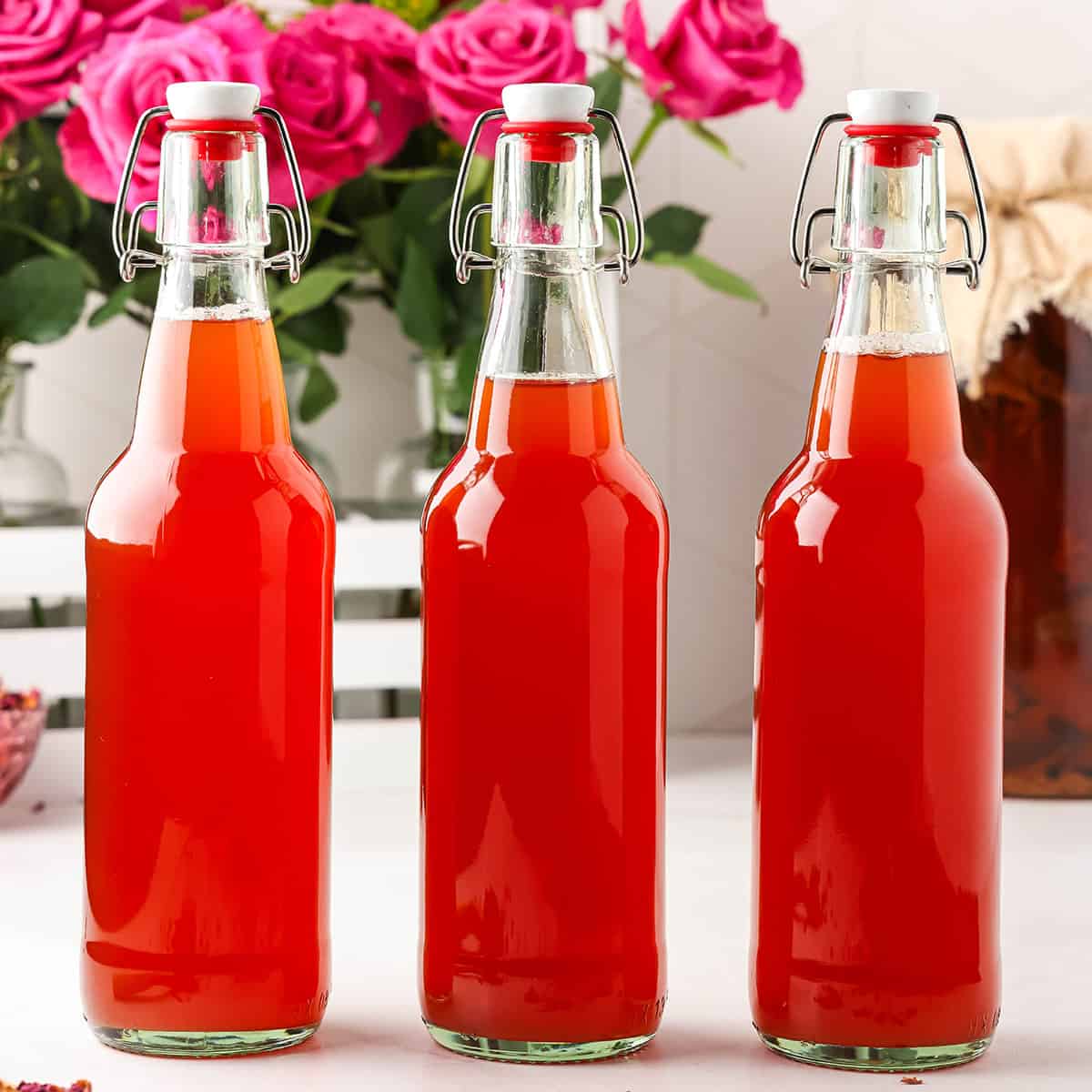
Want to save this post for later?
Kombucha Second Fermentation
Brewing kombucha at home is a delicious and fun way to add some probiotics and other health benefits to your daily routine. Flavoring already brewed kombucha with a second fermentation process is easy!
This recipe begins with a base of kombucha, so if you don’t have that started yet head over to my basic recipe for how to brew kombucha, it’s easy enough for beginners!
Once you have a batch of first fermented booch, it’s time to flavor it and add to the bubbly goodness with second fermentation.
There are tons of options for flavoring kombucha. Some popular ones include strawberry, ginger, hibiscus, lavender, watermelon, and even dandelion. Rose is less popular, but it’s one of my favorites.
The flowers and herbs add to the health benefits of this probiotic-rich drink, so I encourage you to make them all! Make this rose kombucha recipe to get the benefit of roses which are:
- anti-inflammatory
- antioxidant
- high in vitamin C
- helpful for digestion
- stress reducing
- cramps relieving
The fizz in rose kombucha is less intense as fruit kombucha brews, and the sweetness of the roses are a lovely counter balance to the tart vinegar flavor. It’s summer in a glass!

How to Make Rose Kombucha
Rose kombucha has a sweet and lightly floral taste, with delicate bubbles that are perfect for summer. This recipe can be made with black tea or green tea kombucha, depending on preference.
Ingredients
Dried rose petals: If you have roses you can dry your own petals, or feel free to purchase some online. I recommend buying from Mountain Rose Herbs.
Sugar: Since it fuels the fermentation process and is what creates the bubbles, sugar is a must. I use organic granulated sugar. It’s okay to use more or less sugar on your taste preference.
Fermented kombucha: It’s easy to brew your own kombucha! Any unflavored kombucha will work as a starter though, so grab some from a friend’s batch, or use store bought as long as it’s raw.
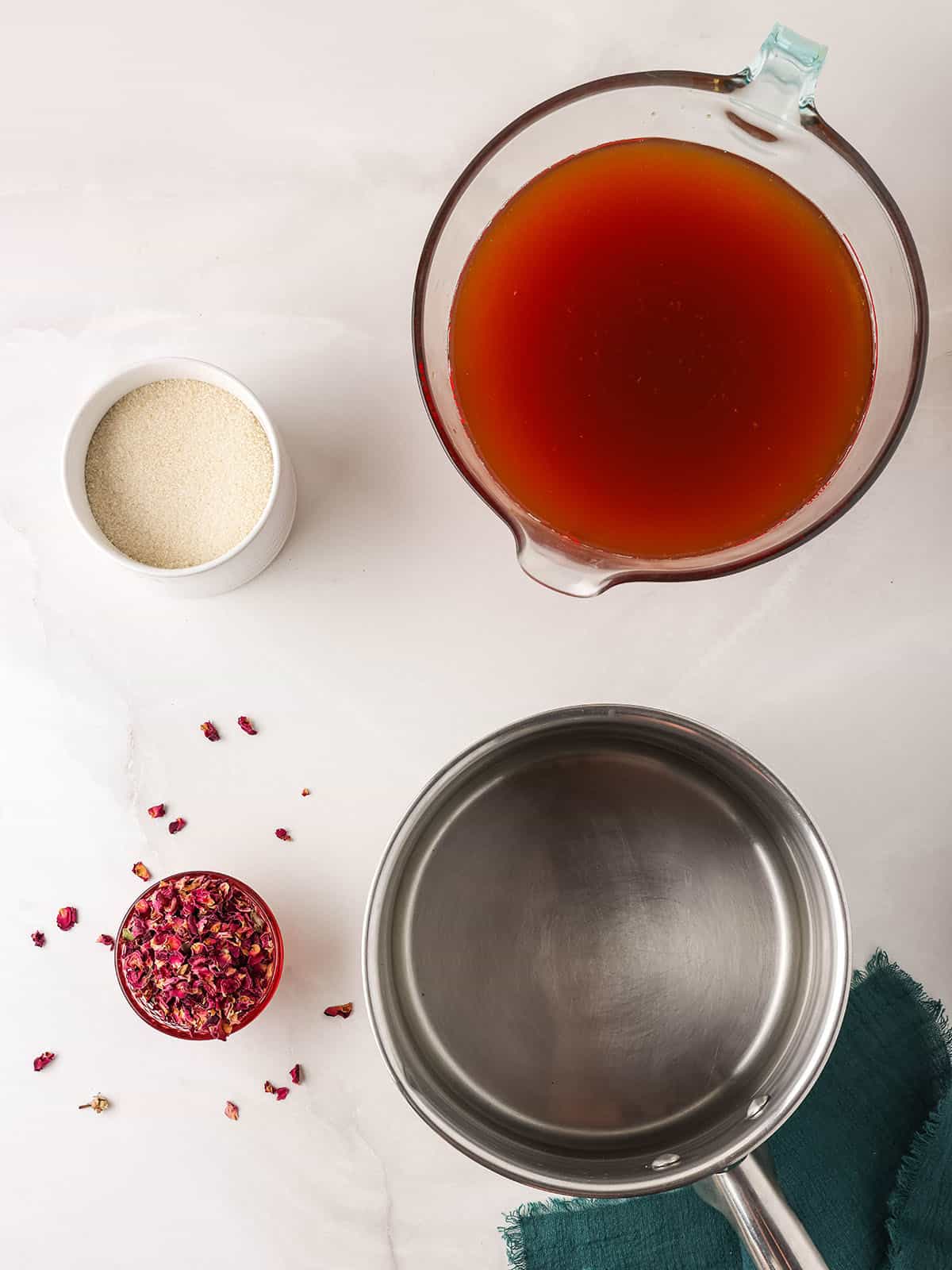
Note: I like GT’s original kombucha if you don’t have the bandwidth to brew your own original kombucha and need to buy some. It’s unpasteurized and is delicious every time, and really high quality.
Rose Kombucha Second Ferment
First, to make the rose tea, put the dried rose petals and water into a pot and bring to a boil. Cover the pot, reduce the heat and gently boil for 10 minutes, then remove the pot from the heat.
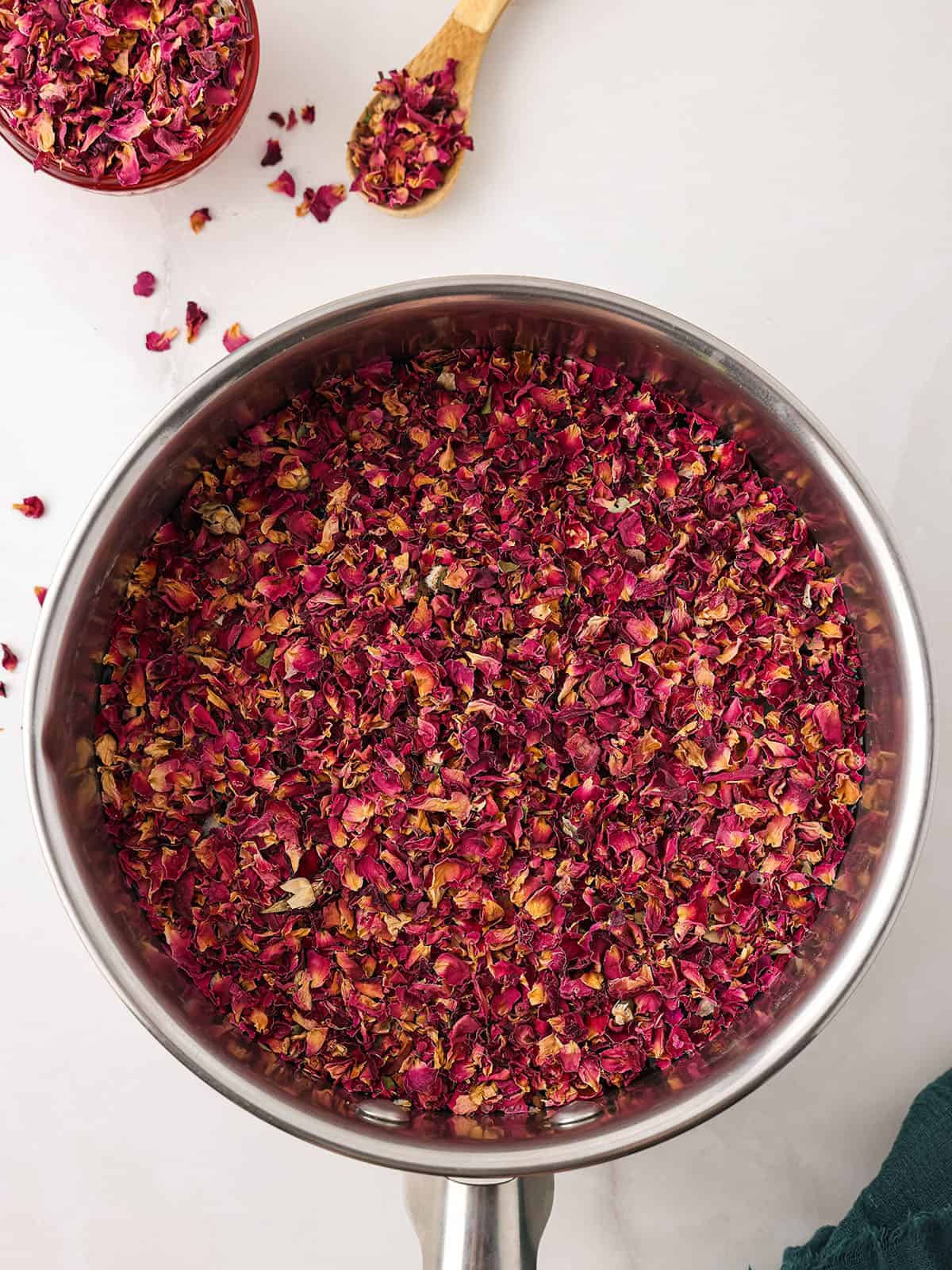
Then, add the sugar to the rose tea and stir it until it dissolves and let the tea cool down completely to room temperature.
Gently swirl the fermented kombucha (from the first fermentation process) before you pour it into the bottles to evenly distribute the yeast.
Then, pour one cup of the original kombucha brew into each bottle, until it’s about halfway full.
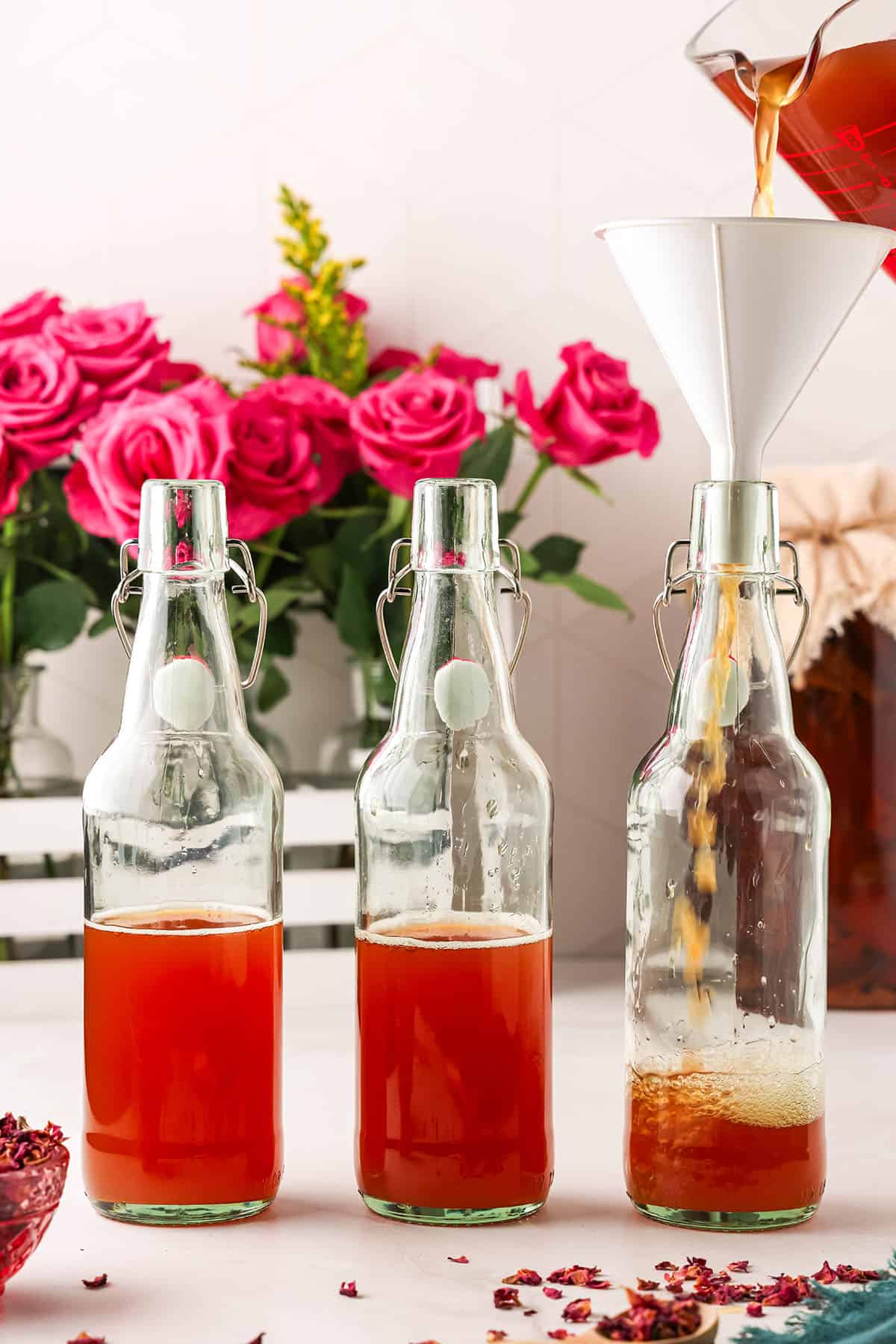
Next, pour about one cup of rose tea into each bottle. You can use a funnel with a fine mesh sieve to strain out the rose petals.
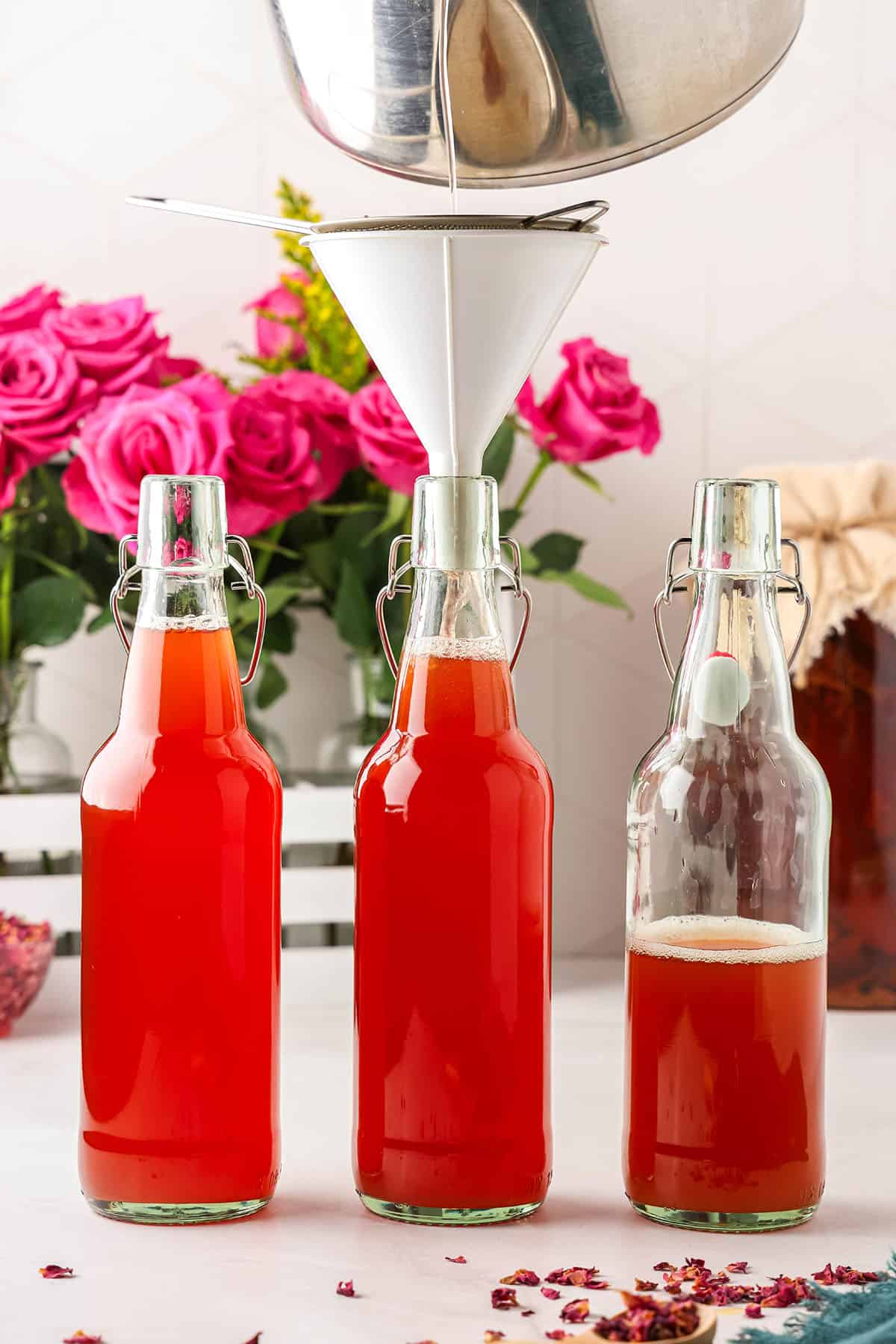
Note: I like the balance of using half kombucha and half rose tea per bottle, but this can also be adjusted to your liking.
Make sure to leave about 1-2 inches in the neck of the bottles for headspace so there is room for pressure to build without the bottles exploding.
Seal the bottles and shake them gently to mix the kombucha together with the tea.
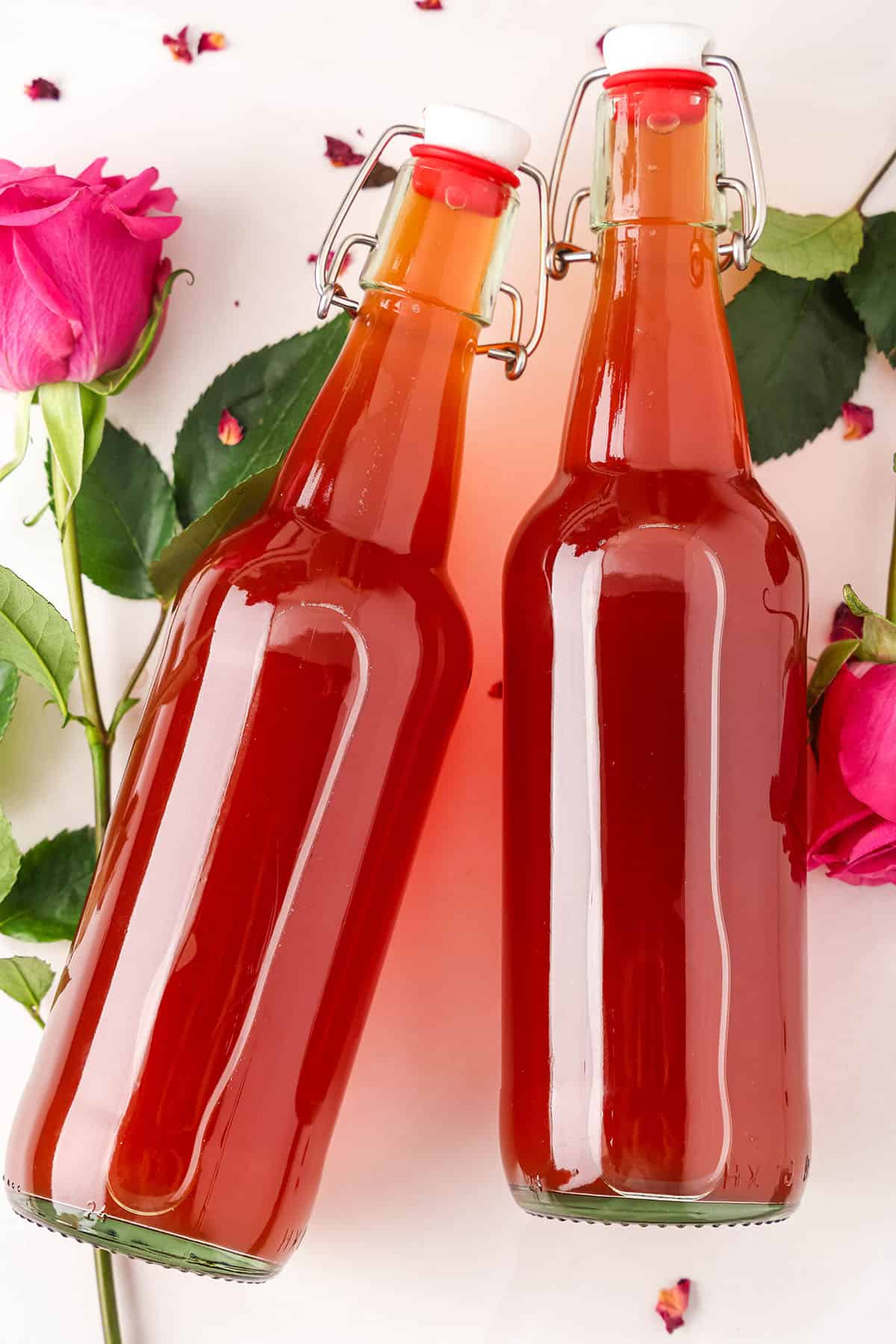
Place the bottles in a room that is out of direct sunlight, and where you will remember to check on them daily. If they’re out of sight, set an alarm to check them. Out of sight out of mind is a real thing!
As the fermentation process occurs, you will notice little bubbles forming at the top and the yeasts will float. Check the bottles daily and “burp” them at least once a day to release pressure.
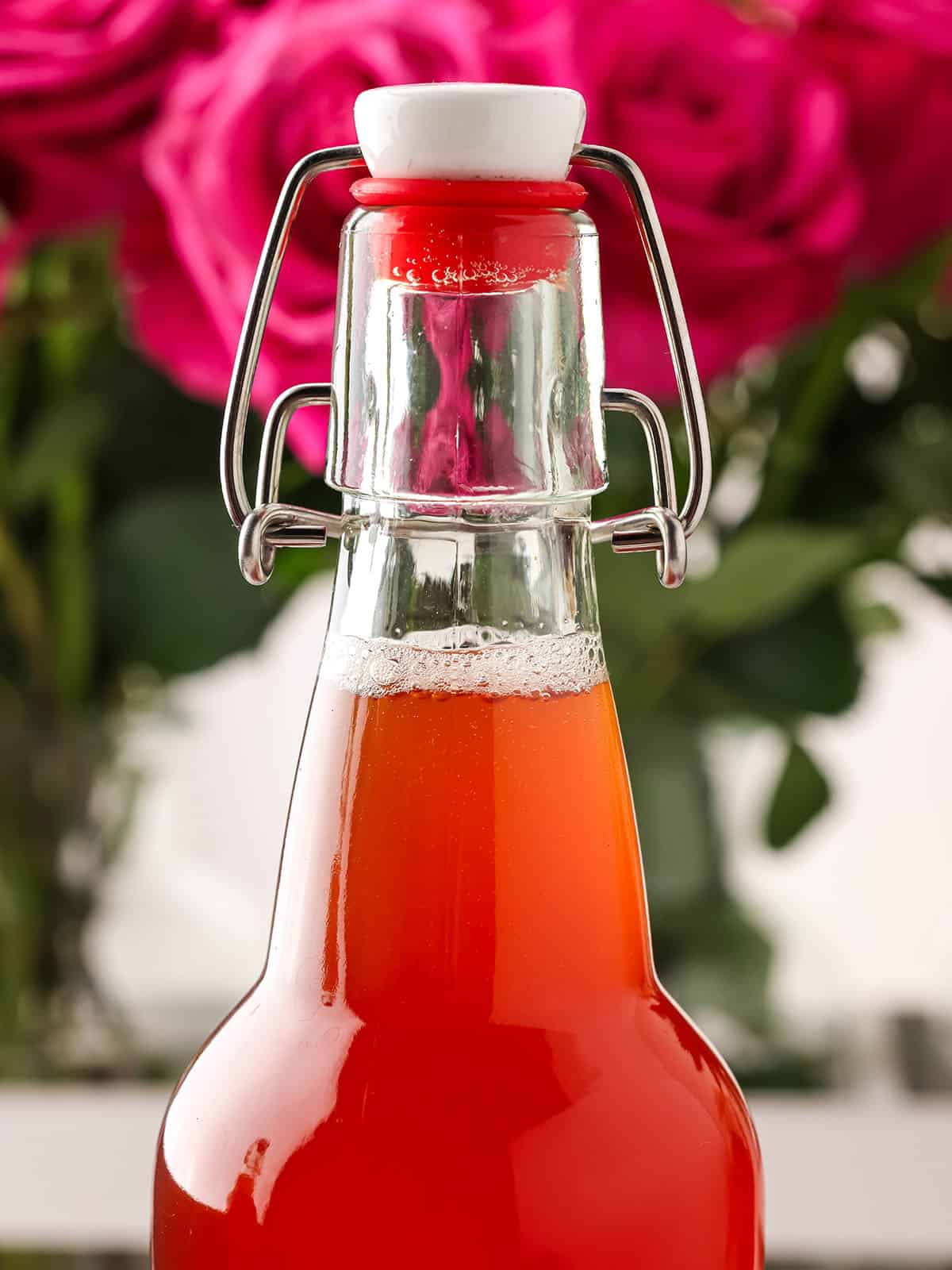
How Long Should Kombucha Ferment?
When you burp the bottles to release the pressure, check to see how quickly the bubbles race to the top.
If you only see a few bubbles and they are slow to make their way to the top, you can replace the lid and check the next day.
Or, if the pressure release is loud and bubbles race to the top, then you know it is time to move that bottle to refrigeration!
Depending on the ambient air temperature, it can take anywhere from 2 to 5 days or so before the rose kombucha is ready to move to the refrigerator.
Note: In cooler weather, kombucha takes longer to ferment. In warmer weather, the process goes much faster. Keep this in mind as it will vary by season and region!
I recommend checking your bottles daily until you get familiar with the process and about how long it takes in your area, home temperature, and location.
Refrigeration slows the process, which will keep the kombucha from exploding under pressure. No one wants that kind of surprise!
This kombucha will get slightly fizzy after a few days but be cautious because the longer it goes through the second fermentation process, the more vinegar-tasting it will be.
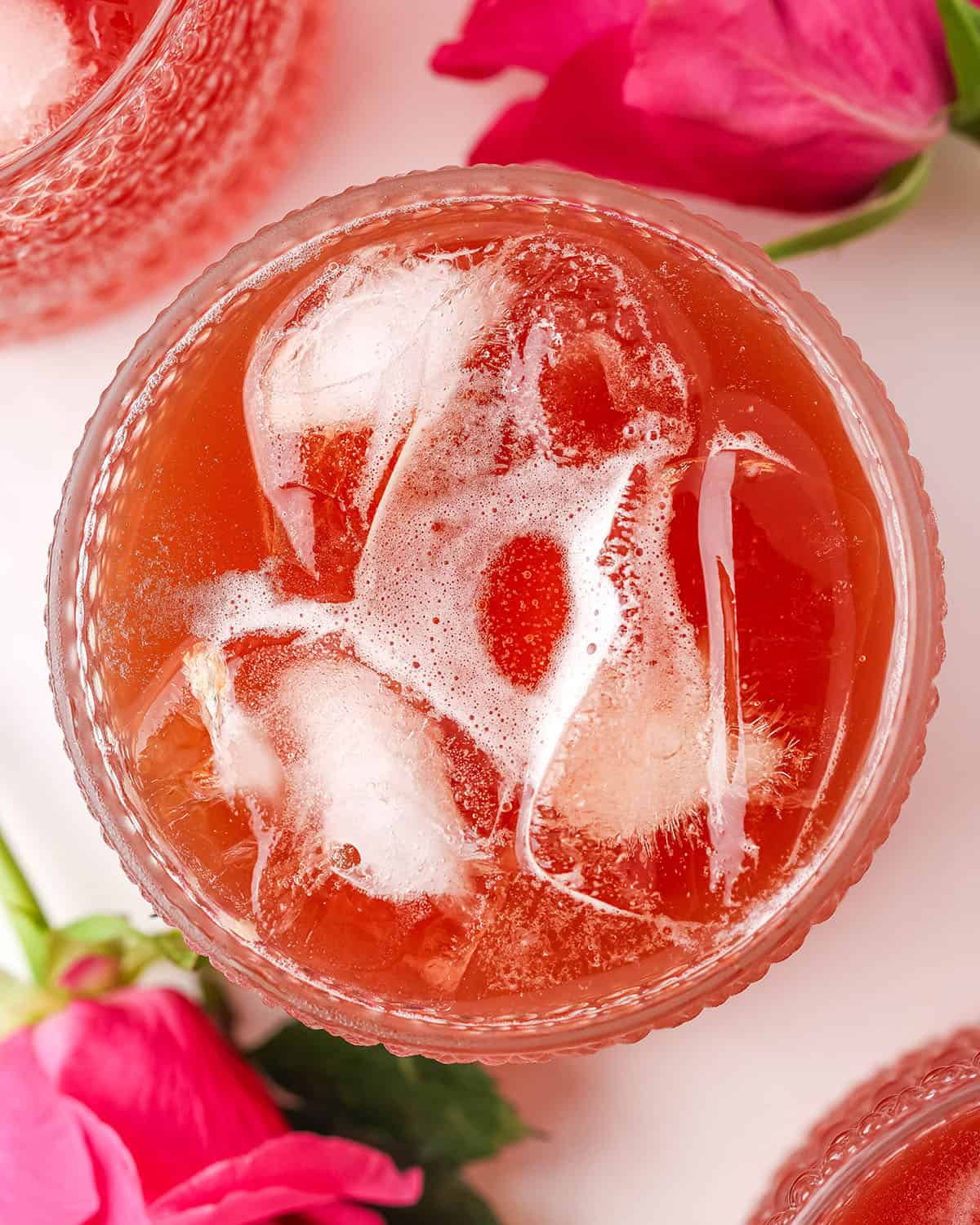
The light floral accents can get lost quickly in the vinegary taste of the kombucha if the second fermentation process goes too long. It’s a balance and you should expect only light carbonation.
The carbonation in rose kombucha will be light, since it doesn’t produce as much carbonation as a fruity kombucha. For this recipe, generally I recommend second fermenting for only 3-5 days, and no longer.
Serving Rose Kombucha
This light and bubbly drink is best served chilled on a warm spring or summer day. I love to drink it when the roses are blooming, but it’s delicious anytime!
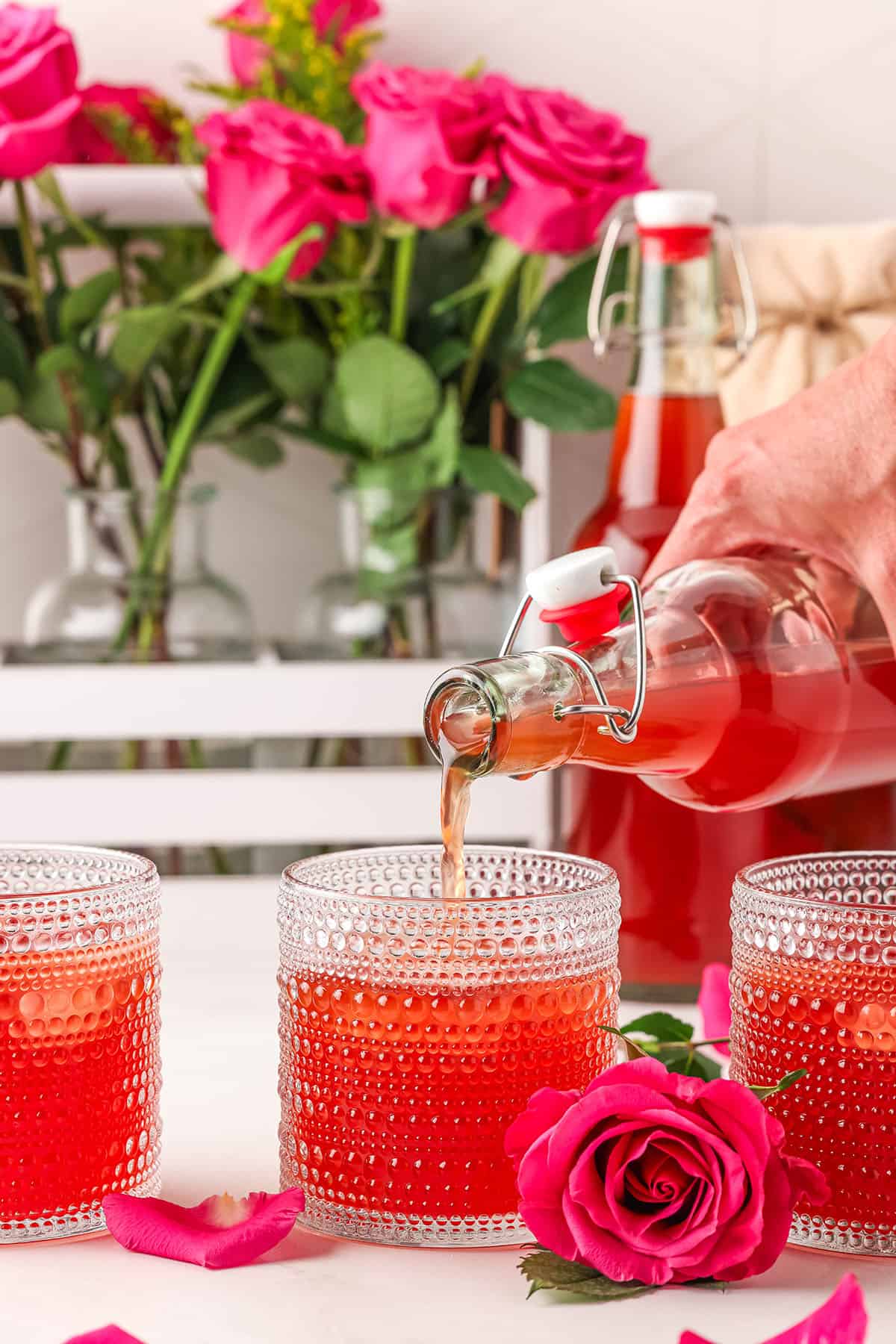
This kombucha can also be chilled and enjoyed right away if you prefer to skip the second fermentation process. Cheers to edible flowers and gut health!
More Fermented Drinks
- Strawberry Water Kefir
- How to Make Water Kefir
- 12 Fermented Soda Recipes
- Pine Needle Soda
- Strawberry Rhubarb Soda
Best Kombucha Flavors
- Blueberry Kombucha
- Dandelion Kombucha
- Ginger Kombucha
- Hibiscus Kombucha
- Lavender Kombucha
- Strawberry Kombucha
- Watermelon Kombucha
- Blackberry Kombucha
- Green Tea Kombucha
- Elderberry Kombucha
- Apple Ginger Kombucha
- Pumpkin Kombucha
- Cranberry Kombucha
Rose Kombucha: Second Ferment
Ingredients
- 6 heaping tablespoons dried rose petals
- 6 cups water
- 3/4 cup sugar
- 6 cups fermented kombucha
Instructions
- Put the dried rose petals and water into a pot and bring to a boil. Cover the pot, reduce the heat and gently boil for 10 minutes, then remove the pot from the heat.
- Add the sugar to the rose tea and stir to dissolve.
- Let the tea cool completely to room temperature.
- Gently swirl the fermented kombucha (from the first fermentation process) before you pour it into the bottles to evenly distribute the yeast, then pour one cup of brewed kombucha into each bottle.
- Then pour about one cup of rose tea into each bottle, using a funnel with a fine mesh sieve to strain out the rose petals. Leave about 1-2 inches in the neck of the bottles for headspace.
- Seal the bottles and shake them gently to mix.
- Place the bottles in a room that is out of direct sunlight, and where you will remember to check on them daily.
- As the fermentation process occurs, you will notice little bubbles forming at the top and the yeasts will float. Check the bottles daily and “burp” them at least once daily to release pressure. If there is built up pressure and bubbles race to the top, then move the bottles to the refrigerator. Depending on the ambient air temperature, this can take anywhere from 2 to 5 days or so.
- Best served chilled on a warm spring or summer day.
Notes
- More or less sugar can be used based on your preference.
- Rose kombucha can be made with black tea or green tea fermented kombucha.
- I like the balance of using half kombucha and half rose tea per bottle, but this can also be adjusted to your liking.
- Rose kombucha will not get as fizzy as fruit kombuchas. You can expect a sweet, light floral taste to counterbalance the tart kombucha flavor.
- This kombucha can be chilled and enjoyed right away if you prefer to skip the 2nd fermentation process.
- When you burp the bottles to release the pressure, check to see how quickly the bubbles race to the top. If you only see a few bubbles and they are slow to make their way to the top, you can replace the lid and check the next day. If the pressure release is loud and bubbles race to the top, then you know it is time to move that bottle to refrigeration!
- In cooler weather, kombucha takes longer to ferment. In warmer weather, the process goes much faster. I recommend checking your bottles daily until you get familiar with the process and about how long it takes in your situation.
- Refrigeration slows the process, which will keep the kombucha from exploding under pressure.





Leave a Reply